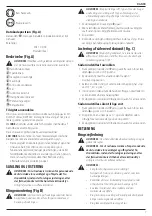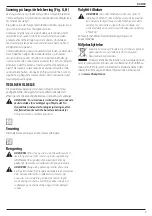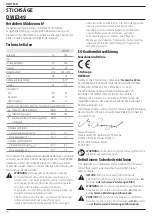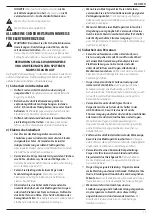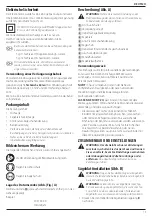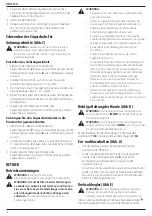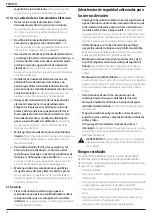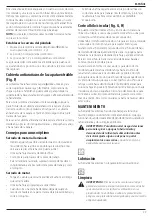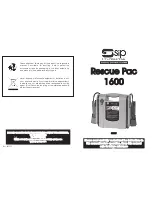
19
EngLIsh
Residual Risks
In spite of the application of the relevant safety regulations
and the implementation of safety devices, certain residual risks
cannot be avoided. These are:
• Impairment of hearing.
• Risk of accidents caused by the uncovered parts of the
saw blade.
Additional Safety Warnings for Jigsaws
•
Hold the power tool by insulated gripping surfaces,
when performing an operation where the cutting
accessory may contact hidden wiring or its own cord.
Cutting accessory contacting a “live” wire may make exposed
metal parts of the power tool “live” and could give the operator
an electric shock.
•
Use clamps or another practical way to secure and
support the workpiece to a stable platform.
Holding the
workpiece by hand or against your body leaves it unstable and
may lead to loss of control.
•
Keep hands away from cutting area. Never reach
underneath the workpiece for any reason.
Do not
insert fingers or thumb into the vicinity of the reciprocating
blade and blade clamp. Do not stabilize the saw by gripping
the shoe.
•
Keep blades sharp.
Dull or damaged blades may cause
the saw to swerve or stall under pressure. Always use the
appropriate type of saw blade for the workpiece material and
type of cut.
•
When cutting pipe or conduit, make sure that they are
free from water, electrical wiring, etc.
•
Do not touch the workpiece or the blade immediately
after operating the tool.
They can become very hot.
•
Be aware of hidden hazards, before cutting into walls,
floors or ceilings, check for the location of wiring
and pipes.
•
The blade will continue to move after releasing the
switch.
Always switch the tool off and wait for the saw blade
to come to a complete standstill before putting the tool down.
WARNING:
We recommend the use of a residual current
device with a residual current rating of 30mA or less.
b )
Use personal protective equipment. Always wear eye
protection.
Protective equipment such as a dust mask,
non-skid safety shoes, hard hat or hearing protection used
for appropriate conditions will reduce personal injuries.
c )
Prevent unintentional starting. Ensure the switch
is in the off‑position before connecting to power
source and/or battery pack, picking up or carrying
the tool.
Carrying power tools with your finger on the
switch or energising power tools that have the switch on
invites accidents.
d )
Remove any adjusting key or wrench before turning
the power tool on.
A wrench or a key left attached
to a rotating part of the power tool may result in
personal injury.
e )
Do not overreach. Keep proper footing and balance
at all times.
This enables better control of the power tool
in unexpected situations.
f )
Dress properly. Do not wear loose clothing or
jewellery. Keep your hair and clothing away from
moving parts.
Loose clothes, jewellery or long hair can be
caught in moving parts.
g )
If devices are provided for the connection of dust
extraction and collection facilities, ensure these are
connected and properly used.
Use of dust collection can
reduce dust-related hazards.
h )
Do not let familiarity gained from frequent use of
tools allow you to become complacent and ignore
tool safety principles.
A careless action can cause severe
injury within a fraction of a second.
4) Power Tool Use and Care
a )
Do not force the power tool. Use the correct power
tool for your application.
The correct power tool
will do the job better and safer at the rate for which it
was designed.
b )
Do not use the power tool if the switch does not turn
it on and off.
Any power tool that cannot be controlled
with the switch is dangerous and must be repaired.
c )
Disconnect the plug from the power source and/
or remove the battery pack, if detachable, from
the power tool before making any adjustments,
changing accessories, or storing power tools.
Such
preventive safety measures reduce the risk of starting the
power tool accidentally.
d )
Store idle power tools out of the reach of children
and do not allow persons unfamiliar with the power
tool or these instructions to operate the power tool.
Power tools are dangerous in the hands of untrained users.
e )
Maintain power tools and accessories. Check for
misalignment or binding of moving parts, breakage
of parts and any other condition that may affect the
power tool’s operation. If damaged, have the power
tool repaired before use.
Many accidents are caused by
poorly maintained power tools.
f )
Keep cutting tools sharp and clean.
Properly
maintained cutting tools with sharp cutting edges are less
likely to bind and are easier to control.
g )
Use the power tool, accessories and tool bits etc.
in accordance with these instructions, taking into
account the working conditions and the work to be
performed.
Use of the power tool for operations different
from those intended could result in a hazardous situation.
h )
Keep handles and grasping surfaces dry, clean and
free from oil and grease.
Slippery handles and grasping
surfaces do not allow for safe handling and control of the
tool in unexpected situations.
5) Service
a )
Have your power tool serviced by a qualified repair
person using only identical replacement parts.
This
will ensure that the safety of the power tool is maintained.
Summary of Contents for DWE349
Page 1: ...DWE349 ...
Page 3: ...1 Fig A Fig B Fig C 4 3 10 9 1 2 8 7 5 6 3 6 7 11 xx xx xxxx ...
Page 4: ...2 Fig D Fig F Fig E 8 13 12 9 6 5 ...
Page 5: ...3 Fig G Fig H ...



